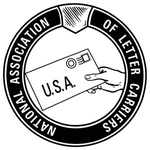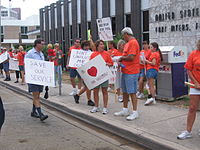- National Association of Letter Carriers
-
NALC 
Full name National Association of Letter Carriers Founded 1889 Members 300,000 Country United States Affiliation AFL-CIO, UNI Key people Fredric V. Rolando, President
Myra Warren, Director of Life Insurance
Timothy C. O'Malley, Executive Vice President
George C. Mignosi, Vice President
Jane E. Broendel, Secretary-Treasurer
Nicole Rhine, Assistant Secretary-Treasurer
Lew Drass, Director of City Delivery
Manuel L. Peralta Jr., Director of Safety & Health
Ernie Kirkland, Director of Retired Members
Brian E. Hellman, Director Health Benefit PlanOffice location Washington, D.C. Website www.nalc.org The National Association of Letter Carriers (or NALC) is an American labor union, representing non-rural letter carriers employed by the United States Postal Service. It was founded in 1889.
Contents
Early History
In 1889, knowing many of their colleagues would be attending the Grand Army of the Republic encampment in their city that summer, Milwaukee letter carriers issued a call to meet during the reunion to form a national association. Sixty letter carriers from 18 states gathered in the meeting room above Schaefer's Saloon on Plankinton Avenue in Milwaukee. On August 29, 1889 they unanimously adopted a resolution to form a National Association of Letter Carriers. The next day, the convention elected officers and adopted a number of resolutions.
The NALC officially became affiliated with the American Federation of Labor (which would later merge with the Congress of Industrial Organizations and become the AFL-CIO) on September 20, 1917 and remains affiliated today.
1970 Strike
Letter carrier morale plummeted during the mid-1960s as inflation eroded carriers' salaries. A growing sense of militancy developed as carriers and their families in big cities neared the poverty level.
In New York City's Branch 36, a storm of protest erupted when President Richard Nixon provided only a 4.1 percent pay raise in 1969, far below what was needed. Events escalated as the Christmas mail rush neared and Nixon called NALC President James Rademacher to the White House to forge a compromise that tied a pay raise in 1970 to the concept of an independent postal authority to bargain with postal unions.
The Nixon-Rademacher agreement incensed letter carriers and when a House committee the following March approved a bill reflecting the Nixon-Rademacher compromise, calls for a strike were shouted in New York's Branch 36 and other branches.
Despite being barred from participating in a strike, on March 17, 1970, the votes were counted in Branch 36, and a long-threatened strike was approved, 1,555-1,055. At 12:01 a.m. March 18, picket lines by Branch 36 went up at post offices throughout Manhattan and the Bronx in New York City as letter carriers went on strike. Within two days, over 200,000 letter carriers and other postal employees across the country had joined the walkout.
Nixon called out 25,000 soldiers to move the mail in New York City. The strike ended after eight days when local NALC leaders assured strikers that an agreement had been reached, even though their word was premature. Round-the-clock negotiations began and on April 2 a satisfactory agreement was reached, which was quickly approved by Congress.
Laying The Groundwork For The Future
The militancy that came out of New York's Branch 36 during the strike changed forever the nature of the NALC.
In 1971, a nationwide rank-and-file movement led by Vincent R. Sombrotto of Branch 36 was formed with goals of giving members the right to vote directly for national union officers and ending a proxy system that had prevented non-incumbents from breaking into the union's power structure.
Sombrotto was elected national president in 1978, ousting incumbent President J. Joseph Vacca. He moved quickly to enhance the union's lobbying power with Congress and the Executive Branch, as well as the NALC's stature within the trade union movement.[1]
Membership and politics
Like most other unions in the United States, NALC is involved politically and has largely supported the Democratic Party, although has been critical of Democrats on occasion, such as President Lyndon B. Johnson when he vetoed a postal pay raise in the mid-1960s. The union has also supported individual Republican candidates.
Prior to the Postal Reorganization Act of 1970, the United States Postal Service was an federal executive department, and the Postmaster General was member of the Cabinet. The rate of postal pay was set by the Congress by federal law, meaning that the Postal Service and its employees were deeply affected by Congress. The NALC strongly supported the Postal Reorganization Act.
NALC's expertise has traditionally been in lobbying than in traditional labor-management relations and collective bargaining. Like all federal agencies under the Taft–Hartley Act, the Postal Service is an "open shop," and no one can be compelled to join the NALC or any other union as a condition of gaining or continuing employment with the government. Other federal laws prohibit letter carriers, like other public employees, from striking. Nonetheless, over 93 percent of all working letter carriers are members of the NALC and the union is now recognized as the collective bargaining agent for all city carriers.[2]
The NALC distinguishes itself from other unions in several ways. For example, membership is completely voluntary; NALC states that is membership includes 300,058 active and retired members, including 214,084 are active city delivery letter carriers employed by the U.S. Postal Service. NALC also refers to its chapters as "branches" rather than "locals."
NALC developed its own retirement community for its members in Nalcrest, Florida. It also operates a mutual benefit association which sells life insurance to members, has its own health benefit plan - the NALC Health Benefit Plan, which predates the Federal Employees Health Benefit Plan, in which NALC also participates.
Issues
Over the years, the union has worked to negotiate wages and working conditions. Some of the negotiated issues are: the maximum weight of an item that an employee may be required to lift, the maximum weight that an employee can be required to carry in his/her satchel, safe delivery methods, and the Letter Carrier uniform. Activists stress that the Postal Service management style is often one of the more dictatorial ones in the modern United States, and imply that this is one of the reasons that a seemingly disproportionate number of USPS employees become infamous for "going postal", although they also point out that the vast majority of such employees were not members of the union.
The future of the union, and the post office itself, is threatened by the march of technology, with the Internet, fax, electronic bill-paying, and other forms of communication that do not involve the physical transportation of pieces of paper from one location to another.
The NALC is opposed to postal privatization and to any termination of the USPS postal monopoly on first-class mail, as well as to contract delivery service (CDS), the contracting out of postal work to non-USPS independent contractor employees (see Star routes), who have lower wages (and fewer benefits or none at all) than USPS employees.[3] The union emphasizes that these workers are subjected to minimal screening and believes that contract delivery inhibits the security, sanctity and service of the USPS. The union supported a Congressional resolution, H.Res. 282, to this effect.[4] and S. 1457[5].
Charitable and philanthropic activities
The union has a close relationship with Jerry Lewis and his annual Labor Day telethon and is invariably one of the groups showcased by the Muscular Dystrophy Association.
Another yearly charitable event for the NALC is the one day food drive Stamp Out Hunger, which is the largest single day food collection in the United States. City & Rural Letter Carriers collect food from Americans as they deliver them their mail. Letter carriers also promote this event heavily.
Beginning in 1993, the NALC, Campbell Soup, Valpak, United Way of America, Feeding America, the AFL-CIO & cartoonist Bil Keane have partnered for the largest single day food collection in the nation. In 2010, the NRLCA became a full partner in the annual drive (though the NRLCA had participated in the drive from its inception), and the drive collected a record 77.1 million lbs. of non-perishable food for the needy from postal customers. That brought the total for the first eighteen years to over a billion pounds.[6]
Branches
The NALC has 2,500 local branches representing letter carriers in all 50 states, the District of Columbia, Puerto Rico, the Virgin Islands and Guam.[7]
Presidents
Since its founding in 1889, the NALC has had 17 presidents:
- William H. Wood, 1889-1890
- John J. Goodwin, 1890-1891
- Theodore C. Dennis, 1891-1892
- Frank E. Smith, 1892-1893
- C.C. Couden, 1894
- R.F. Quinn, 1895
- John N. Parsons, 1896-1900
- James C. Keller, 1901-1905
- Jeremiah D. Holland, 1905-1907
- William E. Kelly, 1907-1914
- Edward J. Gainor, 1914-1941
- William C. Doherty, 1941-1962
- Jerome J. Keating, 1962-1968
- James H. Rademacher, 1968-1977
- J. Joseph Vacca, 1977-1978
- Vincent R. Sombrotto, 1979-2002
- William H. Young, 2002-2009
- Fredric V. Rolando, 2009 to present
See also
- National Rural Letter Carriers' Association
- National Postal Mail Handlers Union
- American Postal Workers Union
References
- ^ "Brief History of the NALC," National Association of Letter Carriers.
- ^ "2001-2006 National Agreement between the National Association of Letter Carriers & the United States Postal Service". http://www.nalc.org/depart/cau/pdf/agreemnt/na2001.pdf. Retrieved 2009-08-29.
- ^ "Statement Of Ted Keating, President, National Association Of Postal Supervisors" to the United States House Oversight and Government Reform Subcommittee on Federal Workforce, Post Office, and the District of Columbia, April 17, 2007.
- ^ "Expressing the sense of the House of Representatives that the United States Postal Service should discontinue the practice of contracting out mail delivery services". http://thomas.loc.gov/cgi-bin/bdquery/z?d110:HE00282:@@@P. Retrieved 2009-02-11.
- ^ "A bill to provide for the protection of mail delivery on certain postal routes, and for other purposes". http://thomas.loc.gov/cgi-bin/bdquery/z?d110:SN01457:@@@P. Retrieved 2009-02-11.
- ^ "NALC Food Drive: Feeding America’s Hungry… Learn How You Can Help". 2009-05-09. http://www.usps.com/communications/newsroom/localnews/ky/2009/ky_2009_0429.htm.
- ^ http://www.nalc.org/nalc/facthist/nalcfact.html
AFL–CIO Governance PresidentsGeorge Meany (1955-1979) · Lane Kirkland (1979-1995) · Thomas R. Donahue (1995) · John J. Sweeney (1995-2009) · Richard Trumka (2009- )DepartmentsBuilding and Construction Trades Department · Maritime Trades · Metal Trades · Professional Employees · Transportation Trades · Union LabelConstituency groupsAllied organizationsAllied groupsAmerican Rights at Work · Community Services Network · International Rescue Committee · Jewish Labor Committee · Labor and Working-Class History Association · Working AmericaProgramsAFL-CIO Building Investment Trust · AFL–CIO Employees Federal Credit Union · AFL-CIO Housing Investment Trust · National Labor College · Union PrivilegeAffiliated unions ALPA · ATU · AFGE · AFM · AFSA · AFSCME · AFT · AFTRA · APWU · ATDA · BCTGM · BRS · CSEA · CWA · FLOC · GMPIU · IATSE · Ironworkers · IAFF · AWIU · IAM · Boilermakers · IBEW · IFPTE · ILWU · ILA · Printers & Engravers · Novelty and Production Workers · BAC · IUEC · IUOE · IUPAT · IUPA · MEBA · NATCA · NALC · NFLPA/FPA · NNU · NPMHU · OPEIU · OPCMIA · SIU · SMWIA · TWU · UA · UAW · UMWA · USW · UTU · Roofers and Waterproofers · UWUA · WGAEState federations See also Categories:- United States Postal Service
- AFL–CIO
- Union Network International
- Postal trade unions
Wikimedia Foundation. 2010.

